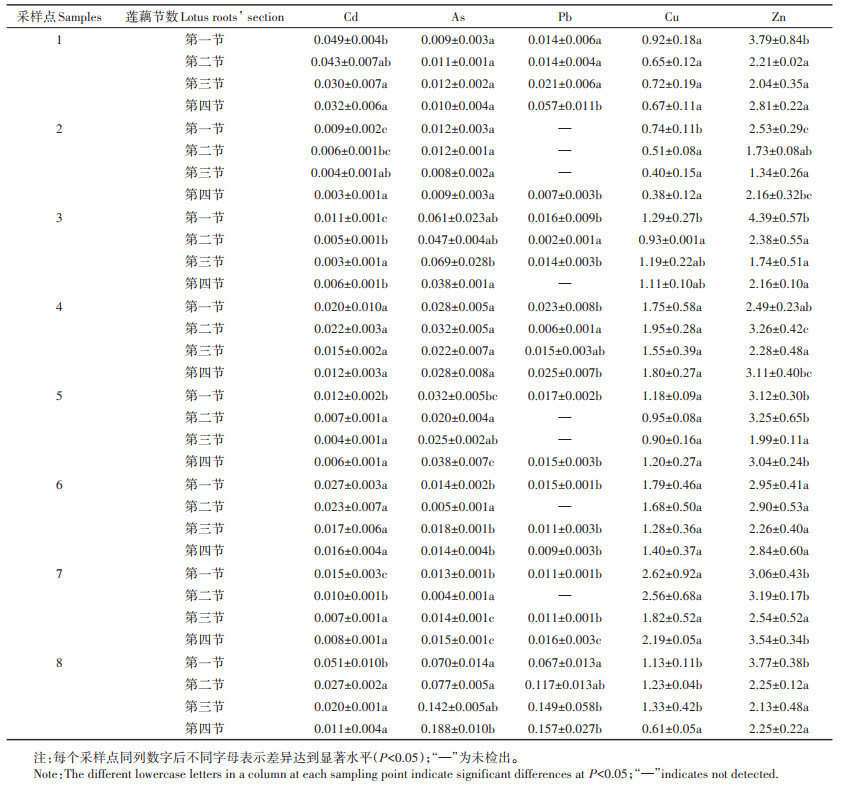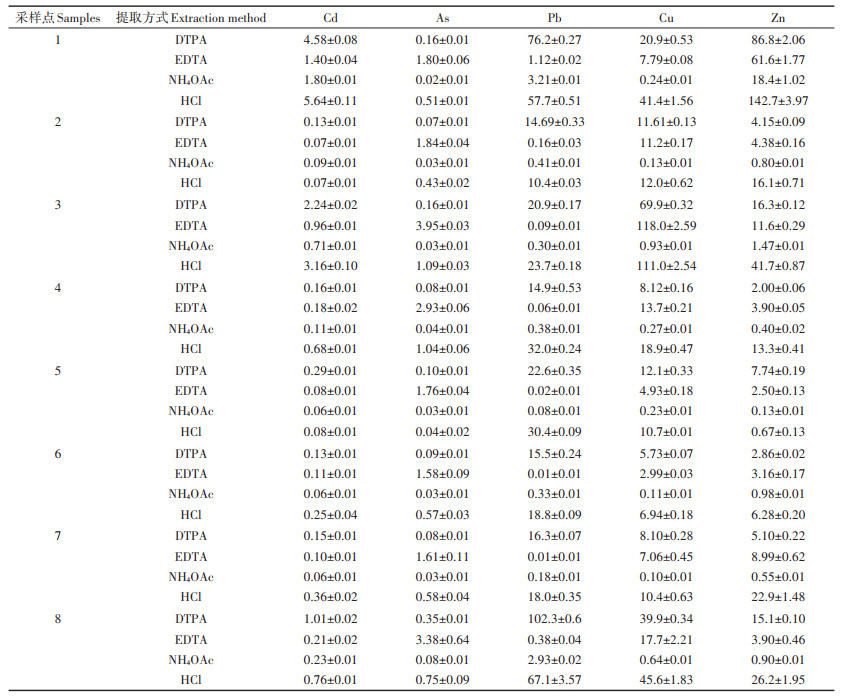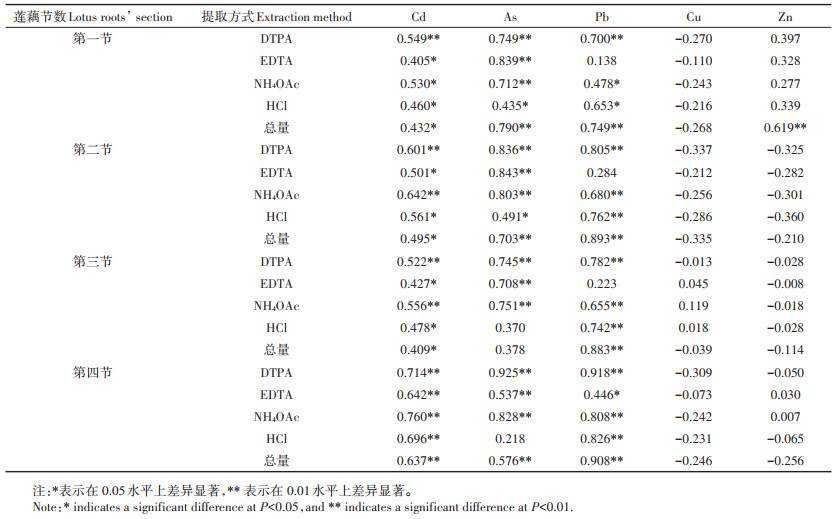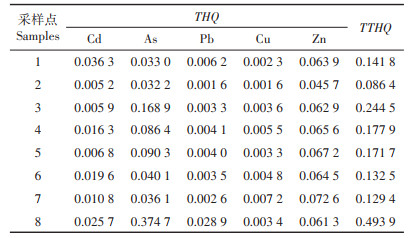土壤不仅是许多动植物赖以生存的场所,也是人们生存及活动的物质基础[1]。近几十年来,以有色金属为代表的重金属污染问题受到政府和学者的广泛关注[2-5]。有色金属的开采往往是造成矿区土壤重金属元素污染的主要原因之一,采矿过程不仅产生矿业固体废物(剥离土、尾矿等)[6],还会产生大量的酸性矿业废水(Acid mine drainage,AMD)[7-8],这些矿业固体废物及酸性矿业废水能够导致周围水体和农田的重金属污染[9-10]。受有色金属污染的土壤不仅直接影响生活在土壤上的动植物[11],还会导致土壤质量和农作物产量及品质的下降,并进一步影响当地居民的身体健康[12]。
安徽省铜陵市是我国重要的有色金属开采、冶炼基地,这些矿产资源的开采已造成了当地农田、河流等不同程度地受到Cd、As、Cu、Zn等重金属元素的污染[13-16],并导致所种植的某些农作物中重金属元素含量升高。对铜陵已进行的研究工作表明,种植在某些田块的蔬菜如青菜、菠菜等食用部分的重金属元素含量超过了国家食品安全限量标准,食用这些蔬菜将会产生一定的健康风险[17]。莲藕(Nelumbo nucifera)作为一种大众喜食的水生蔬菜,在我国具有悠久的栽培历史。铜陵市地表水丰盈,具有较大的莲藕种植面积,所种植的莲藕品种主要为鄂莲3号和鄂莲5号。为提高矿区受重金属元素污染土壤的利用率,降低矿区重金属元素的健康风险,本研究组相继开展了叶菜类、根茎类、豆类等陆生蔬菜重金属元素含量研究[18-20]。本次工作是继前述相关研究之后,专门针对水生蔬菜莲藕重金属元素含量进行的调查,以期为铜陵有色金属矿区污染农田土壤的科学、合理利用,提高农民经济收入、降低区内居民健康风险提供科学依据。
1 材料与方法 1.1 研究区域概况铜陵市地处长江中下游平原与皖南山区的交接地带,属北亚热带湿润季风气候,气候温暖湿润,雨量丰沛,空气湿度较大,年平均气温16.2 ℃,降雨季节为5—9月,无霜期较长[21]。作为我国著名的多金属矿业城市之一,铜陵市已发现的矿产地多达115处,拥有铜官山、狮子山、新桥、凤凰山等矿田,其北部临近长江,多为平原,重金属元素污染程度较低;南部多为低山,矿产资源丰富,农田土壤重金属元素污染较为严重[18]。
1.2 莲藕和土壤样品的采集与预处理在某矿区周边区域选取8处莲藕种植田块,于2018年10月底至11月初采集各种植田块的莲藕(鄂莲3号和鄂莲5号)及对应的土壤。每一种植田块均随机选取3个采样点,每一样点挖取拥有4节或4节以上的新鲜完整莲藕(图 1)。图 1中的第一节为主鞭顶芽之后的新生藕节(俗称“藕头”),2~4节顺序后推,每个藕节为从第四节至第一节随时间的推移逐个生长成熟,对每个藕节单独进行分析测定。各采样点的表层土样(深度0~20 cm)用内径为5 cm的PVC管采集(3次),所采集的土壤样本混合装于洁净的聚乙烯塑料袋内,并及时带回实验室。
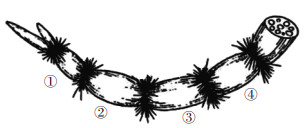
|
①第一节②第二节③第三节④第四节 ①First quarter ②Second quarter ③Third quarter ④Fourth quarter 图 1 莲藕形态示意图 Figure 1 Schematic diagram of lotus roots morphology |
新鲜的莲藕样品用自来水清洗后再用超纯水冲洗多次,后用陶瓷刀将莲藕的1~4节分开,去皮、晾干、称取鲜质量后,于80 ℃烘箱烘干、称重并研磨,研磨好的样本装入洁净的聚乙烯塑料袋内,用于重金属元素的分析。野外采集的土壤样品在剔除砂砾、植物掉落物等之后,于避光透风处自然风干;风干后的土壤用玛瑙研钵研磨(同时挑出较小的植物掉落物)、尼龙网筛筛分,用于土壤pH、土壤重金属元素总量及提取态重金属元素(Cu、Zn、Pb、Cd、As)含量的测定。
1.3 样品分析土壤pH采用pH计(PHS-3C)测定,土水比为1: 2.5(m:V);土壤重金属元素总量用HNO3-HF体系微波消解,莲藕重金属元素总量采用HNO3-H2O2体系微波消解;土壤可提取态重金属元素采用4种提取方法,分别为DTPA提取[22]、EDTA提取(pH=7.0)[23]、NH4OAc提取(pH=7.0)[24]和HCl提取[25]。消解后的土壤和莲藕的重金属总量及各种可提取态样品中重金属元素含量用电感耦合等离子体质谱仪(ICAPQ,Thermo Fisher,美国)测定。测定过程中采用土壤环境标准物质(GSS -15)以及植物标准样品(GBW10020,GBW10048)进行质量控制,各元素加标回收率在92%~108%内,符合元素分析质量控制标准。
1.4 数据分析 1.4.1 转运系数(TF)TF可用于评估莲藕将重金属元素从土壤转移到食用组织的潜在能力,也是评价莲藕可食用部分重金属元素积累程度及污染风险的指标,其计算公式如下[18]:

|
(1) |
式中:CL为莲藕可食用部分重金属元素含量,mg· kg-1,以鲜质量计算,取各节重金属含量平均值;CS为种植莲藕的土壤中重金属元素总量,mg·kg-1。
1.4.2 目标风险指数(THQ)目标风险指数可用于评估当地居民在食用研究区域内莲藕后可能产生的健康风险,当THQ≥1时,食用后则可能存在健康风险,反之则无健康风险,其计算公式如下[26]:

|
(2) |
式中:EF是暴露频率,365 d·a-1;ED是暴露持续时间,相当于平均寿命70 a;FIR是食物摄入量,kg·人-1·d-1,成人摄入量为0.154 95 kg·人-1·d-1[27];C是莲藕可食用部分某种重金属元素的含量,mg·kg-1,以鲜质量计算;RfD是日参考剂量,mg·kg-1·d-1;BW是成年人平均体重,60 kg;AT为平均暴露时间,本研究中为70 a[26];Pb的RfD值参考为0.004 mg·kg-1·d-1,USEPA 2000[28],Cd、As、Zn和Cu的值分别为0.001、0.000 3、0.3、0.04 mg·kg-1·d-1,HJ 25.3—2014。
1.4.3 总目标风险指数(TTHQ)总目标风险指数即为莲藕中各个重金属元素目标风险系数的总和[25]。
1.4.4 数据统计及分析采用Excel 2016对数据进行初步整理并计算平均值、标准偏差、TF、THQ和TTHQ,采用SPSS 21.0进行单因素方差分析、Pearson相关性分析来确定莲藕及土壤中重金属元素的差异性及关联性。
2 结果与讨论 2.1 土壤重金属含量及pH值研究区域土壤pH和重金属元素总量见表 1。表 1表明,研究区土壤pH值在4.80~7.30之间,呈现酸性及中性;5种重金属元素含量范围分别为:Cd 0.17~6.23 mg·kg-1、As 17.48~68.70 mg·kg-1、Pb 27.42~196.1 mg· kg-1、Cu 26.55~417.1 mg·kg-1、Zn 55.03~367.1 mg·kg-1。依据《土壤环境质量农用地土壤污染风险管控标准(试行)》(GB 15618—2018),研究区域Cd污染较为严重,其中1、3号及8号采样点土壤Cd含量分别约为标准的20、8倍和6倍,其余各采样点土壤(除2号采样点外)Cd也存在不同程度的超标;3、4、6、7号及8号采样点As含量分别达到土壤风险管控标准的2.5、1.1、1.2、1.1、2.3倍;1号和8号采样点Pb、Cu、Zn含量也超出土壤风险管控标准,这两个采样点因受酸性矿山废水污染严重,拥有更低的pH值(pH≤5.0)和更高的重金属元素含量[7]。研究区表层土壤重金属元素污染状况总体呈现:Cd>Cu>As>Zn>Pb,整个铜陵矿区较高的Cd、Cu污染也被其他的研究所证实[29-30]。
|
|
表 1 表层土壤重金属元素总量(mg·kg-1) Table 1 Total amount of heavy metal elements in surface soil(mg·kg-1) |
表 2展示了莲藕中重金属元素含量,莲藕的重金属元素Cd、As、Pb、Cu和Zn含量范围分别为:0.003~ 0.051、0.004~0.188、低于检测限~0.157、0.38~2.62 mg·kg-1和1.34~4.39 mg·kg-1。基于《食品污染物限值》(GB 2762—2017)、《食品中铜限量卫生标准》(GB 15199— 1994)和《食品中锌限量卫生标准》(GB 13106— 1991),本研究中莲藕的Cd、As、Pb、Cu、Zn均未超过相关标准,同时莲藕中Cd和Pb平均含量也较生长在同一区域的根类蔬菜萝卜更低[19]。其原因可能是莲藕本身的低重金属富集性,这也说明植物的重金属吸附能力会受到植物种类的影响,各种重金属离子在不同植物中迁移转换的规律存在较大的差异[2-3]。
|
|
表 2 莲藕中重金属元素含量(mg·kg-1,鲜质量) Table 2 Heavy metal content of lotus roots(mg·kg-1, FW) |
单因素方差分析结果表明,在所测定的4节莲藕中,第一节莲藕的Cd和Zn含量高于其他节,其中莲藕的Cd含量呈第一节到第四节逐步降低的趋势。莲藕不同节之间Cd和Zn含量的这种变化可能与重金属元素从地下部向地上部迁移有关[31-32]。而各节之间As、Pb和Cu的含量则与采样点存在联系,如1号与8号采样点莲藕中Cd和Pb含量较高,最大值分别达到0.049 mg·kg-1和0.051 mg·kg-1与0.057 mg·kg-1和0.157 mg·kg-1,3号与8号采样点莲藕As含量分别为0.069 mg·kg-1和0.188 mg·kg-1,高于其他采样点。
2.3 土壤和莲藕中重金属元素含量的相关性比较表 1和表 2可以看出,土壤中重金属元素含量和藕节生长时间长短均能影响莲藕中重金属元素的含量。表 3为莲藕种植区土壤通过4种不同提取剂提取的土壤重金属有效态含量,依据上述3个表的内容,得出不同节莲藕和土壤不同提取方式重金属元素含量及总量的相关性分析(表 4),表明莲藕各节中Cd含量与4种土壤提取态Cd含量及总量Cd之间均存在显著或极显著的正相关;莲藕中各节As含量与土壤的HCl提取态As含量之间相关性相对较差,同样,莲藕中Pb含量与土壤的EDTA提取态Pb含量几乎不存在相关性,而莲藕各节中Cu、Zn的含量也与土壤4种提取态Cu、Zn含量均无相关性。植物体内重金属元素含量与土壤不同提取态元素含量之间的关系非常复杂,如有研究发现植物中的Pb含量与土壤中酸溶态Pb存在显著正相关[33-34],DTPA提取态Zn与植物中Zn含量存在显著相关性[35],但不同提取剂提取的Cu均与植物中Cu含量不存在显著相关性[36]。有研究认为,作物与土壤有效态重金属元素之间的关系除了受作物类型影响,还与污染元素种类等多种因素有关[37]。
|
|
表 3 莲藕种植区土壤提取态重金属含量(mg·kg-1) Table 3 Extracted heavy metal content in lotus root cultivation area(mg·kg-1) |
|
|
表 4 莲藕与土壤中重金属元素含量的相关性 Table 4 Correlation between heavy metal elements in lotus roots and soil |
本研究中,DTPA和NH4OAc作为土壤中Cd、As和Pb提取剂与莲藕中3种元素含量之间具有良好的正相关性,表明以DTPA和NH4OAc作为莲藕种植区土壤3种元素有效态提取剂是非常合适的,可以较好地反映这3种元素在土壤与莲藕间的重金属转移规律。
2.4 莲藕的转运系数转运系数(TF)是评价植物从土壤中吸收转移重金属元素进入植物体能力的指标,同样也是评估重金属元素通过食物链进入人体的关键指标[38]。尽管土壤中重金属元素总量升高会导致莲藕中Cd、As和Pb含量升高(表 3),但莲藕中重金属元素的含量还与其转运系数密切相关。表 5表明,莲藕对5种重金属元素的转运系数均较低,Cd、As、Pb、Cu和Zn的平均转运系数分别为1.48%、0.08%、0.02%、2.32%和1.63%,5种重金属元素的转运系数总体上呈现为Cu>Zn>Cd> As>Pb。Cd作为对人体健康危害严重的重金属元素之一,生长在污染较为严重的1号和3号采样点(表 1)时,莲藕的转移系数总体上仅为0.61%和0.14%。
|
|
表 5 莲藕转运系数(%) Table 5 Transport factor of lotus roots(%) |
作为一种典型的水生蔬菜,与研究区内常见的陆生蔬菜相比,莲藕对Cd的转运系数明显低于茄果类蔬菜(如辣椒、茄子等)[18]和叶类蔬菜(如生菜、圆白菜)[20],王婧文等[39]研究也发现莲藕对Cd转运能力较低。Cd、As和Pb作为对人体健康具有重要影响的重金属元素,莲藕对这些元素的低转运系数也为莲藕的安全食用和受污染土壤的合理利用提供了保障。
2.5 莲藕可食用部分健康风险评价表 6表明,研究区域内所有采样点莲藕中5种重金属元素的目标风险指数(THQ)和总目标风险指数(TTHQ)均小于1。在所调查的8处样点中,8号采样点TTHQ最高,达到0.493 9,较高的TTHQ主要与该采样点As的THQ较高有关。此外,在所研究的铜陵有色金属矿区,相较果蔬类与叶菜类的TTHQ[17-19],莲藕的TTHQ更低,食用种植在受重金属元素污染土壤上的莲藕基本没有健康风险。
|
|
表 6 莲藕目标风险指数值 Table 6 Target hazard quotient of lotus roots |
(1)铜陵矿区周边莲藕种植地土壤存在重金属元素污染问题,其中Cd的污染最为严重,但研究区污染土壤中所种植的莲藕5种重金属元素含量均符合国家相关标准。
(2)莲藕中Cd、As、Pb含量与土壤中DTPA和NH4OAc提取态含量之间存在显著正相关,DTPA和NH4OAc可作为莲藕种植区土壤Cd、As、Pb有效态提取剂。
(3)莲藕对土壤中5种重金属元素的富集能力很低,单一重金属元素THQ及5种重金属元素TTHQ均低于1,食用研究区域内两个品种莲藕对人体健康造成危害的可能性较低;对于铜陵矿区而言,种植两个品种莲藕可提高受重金属元素污染农田的利用率。
| [1] |
Volchko Y, Norrman J, Bergknut M, et al. Incorporating the soil function concept into sustainability appraisal of remediation alternatives[J]. Journal of Environmental Management, 2013, 129: 367-376. DOI:10.1016/j.jenvman.2013.07.025 |
| [2] |
夏芳, 王秋爽, 蔡立梅, 等. 有色冶金区土壤-蔬菜系统重金属污染特征及健康风险分析[J]. 长江流域资源与环境, 2017, 26(6): 865-873. XIA Fang, WANG Qiu-shuang, CAI Li-mei, et al. Contamination and health risk for heavy metals via consumption of vegetables grown in non-ferrous metals smelting area[J]. Resources and Environment in the Yangtze Basin, 2017, 26(6): 865-873. DOI:10.11870/cjlyzyyhj201706009 |
| [3] |
蔡立梅, 王秋爽, 罗杰, 等. 湖北大冶铜绿山矿区蔬菜重金属污染特征及健康风险研究[J]. 长江流域资源与环境, 2018, 27(4): 873-881. CAI Li-mei, WANG Qiu-shuang, LUO Jie, et al. Contamination characteristics and health risk for heavy metals via consumption of vegetables grown in regions affected by Tonglüshan mine in Hubei, China[J]. Resources and Environment in the Yangtze Basin, 2018, 27(4): 873-881. |
| [4] |
张云霞, 宋波, 杨子杰, 等. 广西某铅锌矿影响区农田土壤重金属污染特征及修复策略[J]. 农业环境科学学报, 2018, 37(2): 239-249. ZHANG Yun-xia, SONG Bo, YANG Zi-jie, et al. Characteristics and remediation strategy of heavy-metal polluted agricultural soil near a lead and zinc mine in Guangxi[J]. Journal of Agro-Environment Science, 2018, 37(2): 239-249. |
| [5] |
Du Y, Chen L, Ding P, et al. Different exposure profile of heavy metal and health risk between residents near a Pb-Zn mine and a Mn mine in Huayuan County, South China[J]. Chemosphere, 2019, 216: 352-364. DOI:10.1016/j.chemosphere.2018.10.142 |
| [6] |
高志强, 周启星. 稀土矿露天开采过程的污染及对资源和生态环境的影响[J]. 生态学杂志, 2011, 30(12): 2915-2922. GAO Zhi-qiang, ZHOU Qi-xing. Contamination from rare earth ore strip mining and its impacts on resources and eco-environment[J]. Chinese Journal of Ecology, 2011, 30(12): 2915-2922. |
| [7] |
Simate G S, Ndlovu S. Acid mine drainage:Challenges and opportunities[J]. Journal of Environmental Chemical Engineering, 2014, 2(3): 1785-1803. DOI:10.1016/j.jece.2014.07.021 |
| [8] |
Kefeni K K, Msagati T A M, Mamba B B. Acid mine drainage:Prevention, treatment options, and resource recovery:A review[J]. Journal of Cleaner Production, 2017, 151: 475-493. DOI:10.1016/j.jclepro.2017.03.082 |
| [9] |
周启星. 老工矿区污染生态问题与今后研究展望[J]. 应用生态学报, 2005, 16(6): 1146-1150. ZHOU Qi-xing. Pollution-ecological problems of old industrial and mining areas and future research prospects[J]. Chinese Journal of Applied Ecology, 2005, 16(6): 1146-1150. DOI:10.3321/j.issn:1001-9332.2005.06.034 |
| [10] |
Masindi V, Chatzisymeon E, Kortidis I, et al. Assessing the sustainability of acid mine drainage(AMD)treatment in South Africa[J]. Science of the Total Environment, 2018, 635: 793-802. DOI:10.1016/j.scitotenv.2018.04.108 |
| [11] |
Netto E, Madeira R A, Silveira F Z, et al. Evaluation of the toxic and genotoxic potential of acid mine drainage using physicochemical parameters and bioassays[J]. Environmental Toxicology and Pharmacology, 2013, 35(3): 511-516. DOI:10.1016/j.etap.2013.02.007 |
| [12] |
Zhao H, Xia B, Fan C, et al. Human health risk from soil heavy metal contamination under different land uses near Dabaoshan Mine, Southern China[J]. Science of the Total Environment, 2012, 417(2012): 45-54. |
| [13] |
李如忠, 徐晶晶, 姜艳敏, 等. 铜陵市惠溪河滨岸带土壤重金属形态分布及风险评估[J]. 环境科学研究, 2013, 26(1): 88-96. LI Ru-zhong, XU Jing-jing, JIANG Yan-min, et al. Fraction distribution and ecological risk assessment of soil heavy metals in the riparian zone of Huixi stream in Tongling City[J]. Research of Environmental Sciences, 2013, 26(1): 88-96. |
| [14] |
陈莉薇, 徐晓春, 王军, 等. 铜陵相思河流域重金属分布特征研究[J]. 环境科学, 2014(8): 2967-2973. CHEN Li-wei, XU Xiao-chun, WANG Jun, et al. Distribution of heavy metals in Xiangsi River valley of Tongling, China[J]. Environmental Science, 2014(8): 2967-2973. |
| [15] |
李如忠, 潘成荣, 陈婧, 等. 铜陵市区表土与灰尘重金属污染健康风险评估[J]. 中国环境科学, 2012, 32(12): 2261-2270. LI Ru-zhong, PAN Cheng-rong, CHEN Jing, et al. Heavy metal contamination and health risk assessment for urban topsoil and dust in Tongling City[J]. China Environmental Science, 2012, 32(12): 2261-2270. DOI:10.3969/j.issn.1000-6923.2012.12.022 |
| [16] |
胡星明, 袁新松. 铜陵尾矿土壤重金属污染物的固定修复[J]. 长江流域资源与环境, 2011, 20(11): 1378-1382. HU Xing-ming, YUAN Xin-song. In-situ remediation of mine tailing soil contaminated by heavy metals in Tongling City[J]. Resources and Environment in the Yangtze Basin, 2011, 20(11): 1378-1382. |
| [17] |
李如忠, 潘成荣, 徐晶晶, 等. 典型有色金属矿业城市零星菜地蔬菜重金属污染及健康风险评估[J]. 环境科学, 2013, 34(3): 1076-1085. LI Ru-zhong, PAN Cheng-rong, XU Jing-jing, et al. Contamination and health risk for heavy metals via consumption of vegetables grown in fragmentary vegetable plots from a typical nonferrous metals mine city[J]. Environmental Science, 2013, 34(3): 1076-1085. |
| [18] |
Ding Z, Li Y, Sun Q, et al. Trace elements in soils and selected agricultural plants in the Tongling mining area of China[J]. International Journal of Environmental Research and Public Health, 2018, 15(2): 202. DOI:10.3390/ijerph15020202 |
| [19] |
豆长明, 徐德聪, 周晓铁, 等. 铜陵矿区周边土壤-蔬菜系统中重金属的转移特征[J]. 农业环境科学学报, 2014, 33(5): 920-927. DOU Chang-ming, XU De-cong, ZHOU Xiao-tie, et al. Transfer of heavy metals in soil and vegetable systems nearby Tongling mining area, China[J]. Journal of Agro-Environment Science, 2014, 33(5): 920-927. |
| [20] |
Xu D, Zhou P, Zhan J, et al. Assessment of trace metal bioavailability in garden soils and health risks via consumption of vegetables in the vicinity of Tongling mining area, China[J]. Ecotoxicology and Environmental Safety, 2013, 90: 103-111. DOI:10.1016/j.ecoenv.2012.12.018 |
| [21] |
Sun Q, An S, Yang L, et al. Chemical properties of the upper tailings beneath biotic crusts[J]. Ecological Engineering, 2004, 23(1): 47-53. DOI:10.1016/j.ecoleng.2004.07.001 |
| [22] |
Lindsay E L, Norvell W A. Development of a DTPA soil test for zinc, iron, manganese, and copper[J]. Soil Science Society of America Journal, 1978, 42: 421-428. DOI:10.2136/sssaj1978.03615995004200030009x |
| [23] |
Quevauviller P, Rauret G, Rubio R, et al. Certified reference materials for the quality control of EDTA-and acetic acid-extractable contents of trace elements in sewage sludge amended soils(CRMs 483 and 484)[J]. Fresenius Journal of Analytical Chemistry, 1997, 357(6): 611-618. DOI:10.1007/s002160050222 |
| [24] |
Ure A M. Single extraction schemes for soil analysis and related applications[J]. Science of the Total Environment, 1996, 178(1-3): 0-10. |
| [25] |
Ciaralli L, Giordano R, Lombardi G, et al. Antarctic marine sediments:Distribution of elements and textural characters[J]. Microchemical Journal, 1998, 59(1): 77-88. DOI:10.1006/mchj.1998.1586 |
| [26] |
Shaheen N, Irfan N M, Khan I N, et al. Presence of heavy metals in fruits and vegetables:Health risk implications in Bangladesh[J]. Chemosphere, 2016, 152: 431-438. DOI:10.1016/j.chemosphere.2016.02.060 |
| [27] |
Islam M S, Ahmed M K, Habibullah-Al-Mamun M, et al. The concentration, source and potential human health risk of heavy metals in the commonly consumed foods in Bangladesh[J]. Ecotoxicology and Environmental Safety, 2015, 122: 462-469. DOI:10.1016/j.ecoenv.2015.09.022 |
| [28] |
USEPA. Risk-based concentration table[R]. Washington, D. C.: United States Environmental Protection Agency, 2000.
|
| [29] |
窦智勇, 程建华, 周平, 等. 基于总量及有效态的铜陵矿区农田土壤重金属生态风险评价[J]. 环境污染与防治, 2015, 37(11): 6-10. DOU Zhi-yong, CHENG Jian-hua, ZHOU Ping, et al. Ecological risk assessment based on total and available content of heavy metals in farmland soil of Tongling mining area[J]. Environmental Pollution and Control, 2015, 37(11): 6-10. |
| [30] |
殷汉琴, 陈富荣, 陈兴仁, 等. 铜陵市及其周边地区土壤重金属元素污染评价[J]. 安全与环境学报, 2010, 10(3): 98-102. YIN Han-qin, CHEN Fu-rong, CHEN Xing-ren, et al. Assessment of heavy metal pollutions to the soils in Tongling City, Anhui[J]. Journal of Safety and Environment, 2010, 10(3): 98-102. DOI:10.3969/j.issn.1009-6094.2010.03.025 |
| [31] |
许晓光.莲藕重金属累积特性研究及田间残留现状调查[D].武汉: 华中农业大学, 2011. XU Xiao-guang. Accumulation of heavy metals in lotus root(Nelumbo Nucifera)and investigation of their residues in soil[D]. Wuhan: Huazhong Agricultural University, 2011. |
| [32] |
Xiong C, Zhang Y, Xu X, et al. Lotus roots accumulate heavy metals independently from soil in main production regions of China[J]. Scientia Horticulturae, 2013, 164: 295-302. DOI:10.1016/j.scienta.2013.09.013 |
| [33] |
Liu B, Ai S, Zhang W, et al. Assessment of the bioavailability, bioaccessibility and transfer of heavy metals in the soil-grain-human systems near a mining and smelting area in NW China[J]. Science of the Total Environment, 2017, 609: 822-829. DOI:10.1016/j.scitotenv.2017.07.215 |
| [34] |
Kim J, Kim Y S, Hyun S, et al. Influence of an iron-rich amendment on chemical lability and plant(Raphanus sativus L.)availability of two metallic elements(As and Pb) on mine-impacted agricultural soils[J]. Environmental Science and Pollution Research, 2016, 23(20): 20739-20748. DOI:10.1007/s11356-016-7278-9 |
| [35] |
Soriano-Disla J M, Speir T W, Gómez I, et al. Evaluation of different extraction methods for the assessment of heavy metal bioavailability in various soils[J]. Water, Air, and Soil Pollution, 2010, 213(1-4): 471-483. DOI:10.1007/s11270-010-0400-6 |
| [36] |
Black A, Mclaren R G, Reichman S M, et al. Evaluation of soil metal bioavailability estimates using two plant species(Lolium perenne and Triticum aestivum)grown in a range of agricultural soils treated with biosolids and metal salts[J]. Environmental Pollution, 2011, 159(6): 1523-1535. DOI:10.1016/j.envpol.2011.03.004 |
| [37] |
王蕊, 陈明, 陈楠, 等. 基于总量及形态的土壤重金属生态风险评价对比:以龙岩市适中镇为例[J]. 环境科学, 2017, 38(10): 4348-4359. WANG Rui, CHEN Ming, CHEN Nan, et al. Comparision of ecological risk assessment based on the total amount and speciation distribution of heavy metals in soil:A case study for Longyan City, Fujian Province[J]. Environmental Science, 2017, 38(10): 4348-4359. DOI:10.13227/j.hjkx.201702137 |
| [38] |
Adamo P, Iavazzo P, Albanese S, et al. Bioavailability and soil-toplant transfer factors as indicators of potentially toxic element contamination in agricultural soils[J]. Science of the Total Environment, 2014, 500: 11-22. DOI:10.1016/j.scitotenv.2014.08.085 |
| [39] |
王婧文, 姚欣, 李有志, 等. 东洞庭湖莲藕种植区土壤重金属污染及其对莲藕重金属含量的影响[J]. 生态科学, 2017, 36(4): 46-51. WANG Jing-wen, YAO Xin, LI You-zhi, et al. Heavy metal contamination in soils and their impact on heavy metal content in lotus in the East Dongting Lake[J]. Ecological Science, 2017, 36(4): 46-51. |
 2019, Vol. 38
2019, Vol. 38




